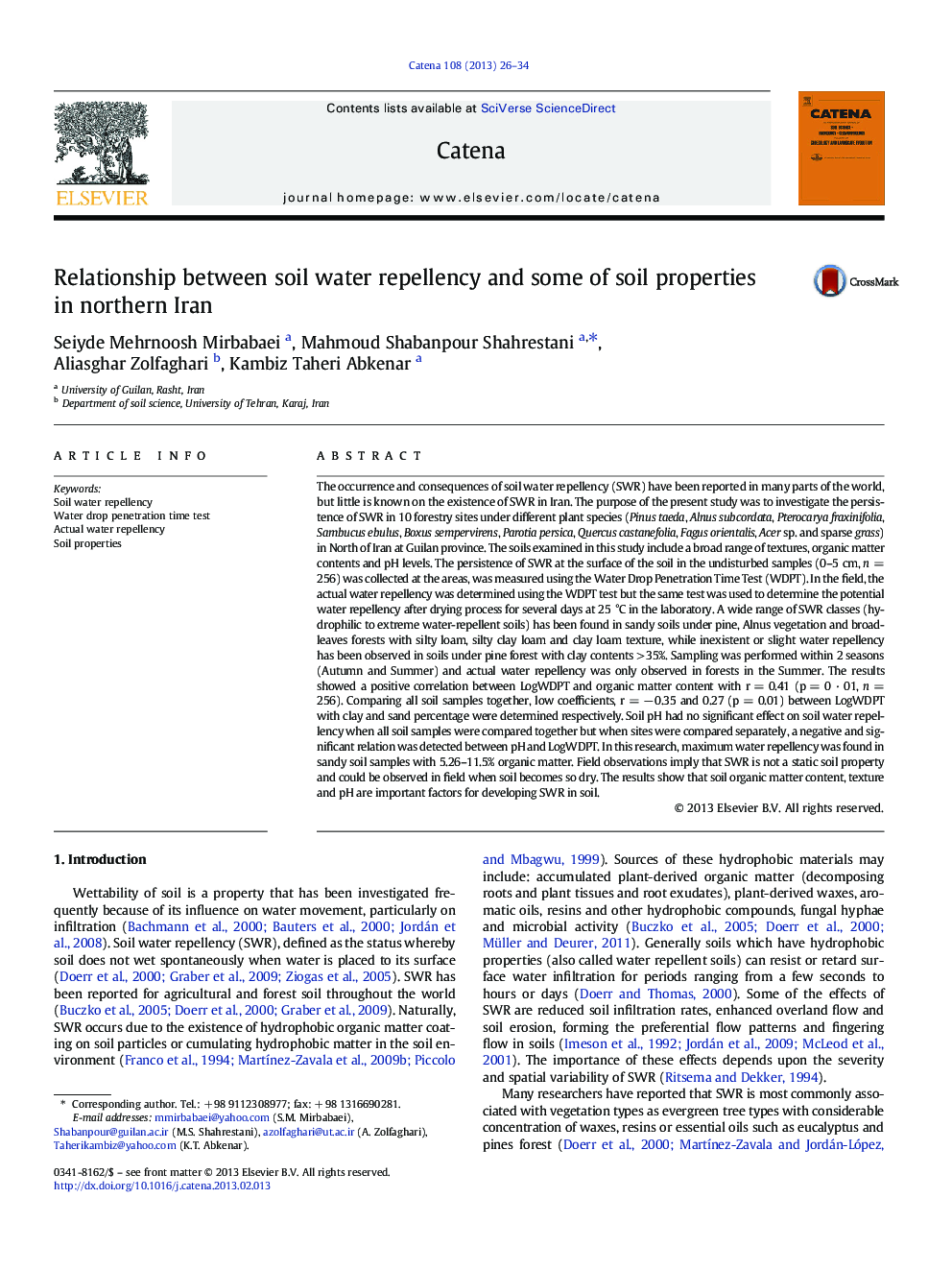| کد مقاله | کد نشریه | سال انتشار | مقاله انگلیسی | نسخه تمام متن |
|---|---|---|---|---|
| 4571596 | 1629244 | 2013 | 9 صفحه PDF | دانلود رایگان |
عنوان انگلیسی مقاله ISI
Relationship between soil water repellency and some of soil properties in northern Iran
دانلود مقاله + سفارش ترجمه
دانلود مقاله ISI انگلیسی
رایگان برای ایرانیان
موضوعات مرتبط
مهندسی و علوم پایه
علوم زمین و سیارات
فرآیندهای سطح زمین
پیش نمایش صفحه اول مقاله

چکیده انگلیسی
The occurrence and consequences of soil water repellency (SWR) have been reported in many parts of the world, but little is known on the existence of SWR in Iran. The purpose of the present study was to investigate the persistence of SWR in 10 forestry sites under different plant species (Pinus taeda, Alnus subcordata, Pterocarya fraxinifolia, Sambucus ebulus, Boxus sempervirens, Parotia persica, Quercus castanefolia, Fagus orientalis, Acer sp. and sparse grass) in North of Iran at Guilan province. The soils examined in this study include a broad range of textures, organic matter contents and pH levels. The persistence of SWR at the surface of the soil in the undisturbed samples (0-5 cm, n = 256) was collected at the areas, was measured using the Water Drop Penetration Time Test (WDPT). In the field, the actual water repellency was determined using the WDPT test but the same test was used to determine the potential water repellency after drying process for several days at 25 °C in the laboratory. A wide range of SWR classes (hydrophilic to extreme water-repellent soils) has been found in sandy soils under pine, Alnus vegetation and broadleaves forests with silty loam, silty clay loam and clay loam texture, while inexistent or slight water repellency has been observed in soils under pine forest with clay contents > 35%. Sampling was performed within 2 seasons (Autumn and Summer) and actual water repellency was only observed in forests in the Summer. The results showed a positive correlation between LogWDPT and organic matter content with r = 0.41 (p = 0 · 01, n = 256). Comparing all soil samples together, low coefficients, r = â 0.35 and 0.27 (p = 0.01) between LogWDPT with clay and sand percentage were determined respectively. Soil pH had no significant effect on soil water repellency when all soil samples were compared together but when sites were compared separately, a negative and significant relation was detected between pH and LogWDPT. In this research, maximum water repellency was found in sandy soil samples with 5.26-11.5% organic matter. Field observations imply that SWR is not a static soil property and could be observed in field when soil becomes so dry. The results show that soil organic matter content, texture and pH are important factors for developing SWR in soil.
ناشر
Database: Elsevier - ScienceDirect (ساینس دایرکت)
Journal: CATENA - Volume 108, September 2013, Pages 26-34
Journal: CATENA - Volume 108, September 2013, Pages 26-34
نویسندگان
Seiyde Mehrnoosh Mirbabaei, Mahmoud Shabanpour Shahrestani, Aliasghar Zolfaghari, Kambiz Taheri Abkenar,